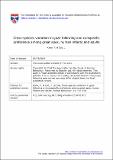Files in this item
Cross-species variation in gaze following and conspecific preference among great apes, human infants and adults
Item metadata
| dc.contributor.author | Kano, Fumihiro | |
| dc.contributor.author | Call, Josep | |
| dc.date.accessioned | 2016-03-09T17:10:04Z | |
| dc.date.available | 2016-03-09T17:10:04Z | |
| dc.date.issued | 2014-05 | |
| dc.identifier | 141911987 | |
| dc.identifier | a13f32d4-227b-4047-a732-2a36671e2959 | |
| dc.identifier | 000336458600018 | |
| dc.identifier | 84898624418 | |
| dc.identifier.citation | Kano , F & Call , J 2014 , ' Cross-species variation in gaze following and conspecific preference among great apes, human infants and adults ' , Animal Behaviour , vol. 91 , pp. 137-150 . https://doi.org/10.1016/j.anbehav.2014.03.011 | en |
| dc.identifier.issn | 0003-3472 | |
| dc.identifier.other | ORCID: /0000-0002-8597-8336/work/37478051 | |
| dc.identifier.uri | https://hdl.handle.net/10023/8392 | |
| dc.description.abstract | Although previous studies have shown that many species follow gaze, few have directly compared closely related species, and thus its cross-species variation remains largely unclear. In this study, we compared three great ape species (bonobos, Pan paniscus, chimpanzees, Pan troglodytes, orang-utans, Pongo abelii) and humans (12-month-olds and adults) in their gaze-following responses to the videos of conspecific and allospecific models. In the video, the model turned his head repeatedly to one of two identical objects. We used a noninvasive eye-tracking technique to measure participants' eye movements, and used both conspecific and allospecific models as stimuli to examine their potential preference in following conspecific rather than allospecific gaze. Experiment 1 presented to great apes the videos of conspecific and human models. We found that all species followed the conspecific gaze. Chimpanzees did not follow the human gaze, whereas bonobos did. Bonobos reacted overall more sensitively than chimpanzees to both conspecific and human gaze. Experiment 2 presented to human infants and adults the videos of human, chimpanzee and orang-utan models. Both infants and adults followed the human gaze. Unlike adults, infants did not follow the ape gaze. Experiment 3 presented to great apes the videos of allospecific ape models. Consistent with experiment 1, chimpanzees did not follow the allospecific ape gaze, whereas bonobos and orang-utans did. Importantly, preferential following of conspecific gaze by chimpanzees (experiment 1) and human infants (experiment 2) was mainly explained by their prolonged viewing of the conspecific face and thus seems to reflect their motivation to attend selectively to the conspecific models. Taken together, we conclude that gaze following is modulated by both subject species and model species in great apes and humans, presumably a reflection of the subjects' intrinsic sensitivity to gaze and also their selective interest in particular models. (C) 2014 The Association for the Study of Animal Behaviour. Published by Elsevier Ltd. All rights reserved. | |
| dc.format.extent | 14 | |
| dc.format.extent | 1047255 | |
| dc.language.iso | eng | |
| dc.relation.ispartof | Animal Behaviour | en |
| dc.subject | Conspecific model | en |
| dc.subject | Gaze following | en |
| dc.subject | Great ape | en |
| dc.subject | Human infant | en |
| dc.subject | Species difference | en |
| dc.subject | Joint visual-attention | en |
| dc.subject | Monkeys Cebus-Apella | en |
| dc.subject | Pan-troglodytes | en |
| dc.subject | Differential sensitivity | en |
| dc.subject | Macaca-Mulatta | en |
| dc.subject | Social cues | en |
| dc.subject | Chimpanzees | en |
| dc.subject | Eye | en |
| dc.subject | Direction | en |
| dc.subject | Orangutans | en |
| dc.subject | BF Psychology | en |
| dc.subject.lcc | BF | en |
| dc.title | Cross-species variation in gaze following and conspecific preference among great apes, human infants and adults | en |
| dc.type | Journal article | en |
| dc.contributor.institution | University of St Andrews. School of Psychology and Neuroscience | en |
| dc.contributor.institution | University of St Andrews. Centre for Social Learning & Cognitive Evolution | en |
| dc.identifier.doi | 10.1016/j.anbehav.2014.03.011 | |
| dc.description.status | Peer reviewed | en |
| dc.identifier.url | http://www.sciencedirect.com/science/article/pii/S0003347214001286#appd001 | en |
This item appears in the following Collection(s)
Items in the St Andrews Research Repository are protected by copyright, with all rights reserved, unless otherwise indicated.

